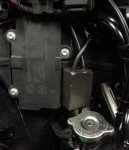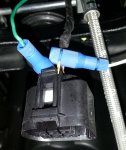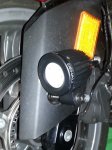Tompierce
New member
Denali D2D LED Install on a C650GT
In this post I am going to review my installation of the Denali D2D LED Dual Intensity Lighting Kit, with some added comments about the Twisted Throttle construction and the WebBikeWorld installation. This is how I did it and what I think. You are free to disagree if you like.
Prerequsites
I needed some additional lighting for my C650GT. The low beam is wide enough but does not illuminate far enough (needs more 'reach'). The high beams are fine, but can't be used all the time. Ideally, the D2Ds will provide some intermediate illumination further than the low beams alone. For that reason, I left the 10 degree spot beam lens installed in the LEDs, and kept the 25 degree wide angle lens for later use.
I plan on keeping this bike for a long time. I am not concerned about keeping it 'stock' or being able to return it to 'stock' condition. As you will see, this gives me freedom to make design decisions that others may not be able to.
Mounting the Lights.
I looked at the WBW article and the extra $70 they spent on the universal mounting kit. I thought there has to be a better way - that does not have all that extra hardware hanging off that little 5mm bolt. So, I ordered a length of 6mm threaded rod (same size as the LED mounting bolt to the saddle). I drilled out the 5mm 'tab' on the lower strut and mounted the rod to the tab with nuts and lockwashers. The rod goes thru the tab, thru the plastic ABS cover (with another nutto hold it in place) and extends out far enough to mount the LED. I didn't even use the u-shaped saddle for the LED but threaded the rod directly through the LED housing mount. Once painted black, it is about as minimal of a mounting as it is possible to fabricate.
Mounting the control box.
I choose to mount the control box the same place that WBW did (on the intake air horn to the right of the air filter under the upper right cover.) But I turned it 90 degrees from how WBW did it so that the wires are not blocking the air filter access. This way the control wires are pointed up and the LED driver wires are pointed down and you can still change the air filter.
Wiring the LEDs.
With the control box mounted, the wires on the LEDs are long enough to reach to the control box without having to use the additional wiring extensions provided for this purpose. Route and secure the wires and simply plug them in. Doublecheck that there is no interference with the steering or suspension.
Wiring the Control box - Power, Switching, and Sensing
One of the cables coming out of the control box is power - it is identified by a Red and Black wire. Since the power leads were not long enough to reach to the battery (and because they came with the wrong size fuse that does not match the rest of the fuses on the bike) I replaced the supplied fuse holder with one of the correct size, and extended the leads far enough to reach the battery.
Area of concern: Undersized power wiring
If you look at the picture below you will see a comparison of the power leads from the control box (on the right) and the power leads to one of the LEDs (on the left). There seems to be a mismatch between the size (and therefore capacity) of the power leads from the control box versus the size of the LED power lead. And remember, there is the current of 2 LEDs plus the control box circuit current all running through what appears to be undersized main power wires. I am not an electrical engineer so I could be wrong, but it looks undersized to my eye. This makes me nervous about running the LEDs on full power for any lenghty period of time.
The remaining cable out of the control box contains the wires for switching the LEDs on and off, and controlling the output intensity.
I decided I hated the included on/off switch, so I replaced it with a panel mounted rocker switch mounted below the BMW emblem in the handlebars. I split the cable back to the control box, and pulled out the Red, White, and Black wires to go to the (non-illuminated) switch I mounted. The Red and the Wite wires control whether the LEDs are on or off, and as far as I can tell, the Black wire is just along for the ride.
The remaining wires are the sensing wires to determine what intensity to run the lights. Since I wanted to run the LEDs at low intensity with the low beams and full intensity with high beams I needed to connect these wires to the headlight.
Unavoidable electrical side note:
Coming out of the control box is a cable with 4 wires: Red, Black, White, and Green. The Red, Black, and White wires run to the on/off switch connector. There is a extra White wire and it and the Green wire (which magically changes to Blue wire inside the cable) are to be used for sensing.
The sensing wires are connected to the headlight as follows: the electrical plug for the headlight it in the rear center of the headlight assembly between the 2 headlight aiming knows. It is difficult to reach, but can be disconnected by reaching behind the headlight from in front of the bike. Once free, there is enough room to attach the Posi-Taps to make the sensing connection.
I am not usually a big fan of press-on or clamp-on electrical connectors (all of the other connections here have been soldered and shrink wrapped), but I am impressed with the PosiTap. For this connection, I don't know how else it could have been done.
There are 4 wires in the headlight connector - Brown (ground), Violet (running lights), Yellow (low beam) and White (high beam). The White sensing wire connects to the Yellow low beam wire (for 12 volts when switched on), and the Green (or Blue) sensing wire connects to the White high beam wire.
Another unavoidable electrical side note:
If you switch the bike on but do not start the engine, neither of the headlights come on. If you press the headlight switch, the low beam comes on. If you hold the switch, the high beam comes on, and the low beam goes out. This only happens with the bike switched on but not running.
If you wire the bike as I did, then with the switch ON but the bike NOT running, you will get no lights at all initially, low beams and low power LEDs if you trigger the headlights, and high beams and NO LEDs when you trigger the high beams (because the low beams went out and the 12 v is not on the sensing wire anymore).
With the engine running you get low beam and low power LEDs. If you turn on the high beams you get low beam and high beam and full power LEDs.
(This might be helpful to remember when demonstrating the LEDs to Officer Friendy by the side of the road some night when you've been pulled over...)
Respond back here if you have questions or comments - as soon as it stops snowing/raining I will post some night pictures so you can all see the results.





In this post I am going to review my installation of the Denali D2D LED Dual Intensity Lighting Kit, with some added comments about the Twisted Throttle construction and the WebBikeWorld installation. This is how I did it and what I think. You are free to disagree if you like.
Prerequsites
I needed some additional lighting for my C650GT. The low beam is wide enough but does not illuminate far enough (needs more 'reach'). The high beams are fine, but can't be used all the time. Ideally, the D2Ds will provide some intermediate illumination further than the low beams alone. For that reason, I left the 10 degree spot beam lens installed in the LEDs, and kept the 25 degree wide angle lens for later use.
I plan on keeping this bike for a long time. I am not concerned about keeping it 'stock' or being able to return it to 'stock' condition. As you will see, this gives me freedom to make design decisions that others may not be able to.
Mounting the Lights.
I looked at the WBW article and the extra $70 they spent on the universal mounting kit. I thought there has to be a better way - that does not have all that extra hardware hanging off that little 5mm bolt. So, I ordered a length of 6mm threaded rod (same size as the LED mounting bolt to the saddle). I drilled out the 5mm 'tab' on the lower strut and mounted the rod to the tab with nuts and lockwashers. The rod goes thru the tab, thru the plastic ABS cover (with another nutto hold it in place) and extends out far enough to mount the LED. I didn't even use the u-shaped saddle for the LED but threaded the rod directly through the LED housing mount. Once painted black, it is about as minimal of a mounting as it is possible to fabricate.
Mounting the control box.
I choose to mount the control box the same place that WBW did (on the intake air horn to the right of the air filter under the upper right cover.) But I turned it 90 degrees from how WBW did it so that the wires are not blocking the air filter access. This way the control wires are pointed up and the LED driver wires are pointed down and you can still change the air filter.
Wiring the LEDs.
With the control box mounted, the wires on the LEDs are long enough to reach to the control box without having to use the additional wiring extensions provided for this purpose. Route and secure the wires and simply plug them in. Doublecheck that there is no interference with the steering or suspension.
Wiring the Control box - Power, Switching, and Sensing
One of the cables coming out of the control box is power - it is identified by a Red and Black wire. Since the power leads were not long enough to reach to the battery (and because they came with the wrong size fuse that does not match the rest of the fuses on the bike) I replaced the supplied fuse holder with one of the correct size, and extended the leads far enough to reach the battery.
Area of concern: Undersized power wiring
If you look at the picture below you will see a comparison of the power leads from the control box (on the right) and the power leads to one of the LEDs (on the left). There seems to be a mismatch between the size (and therefore capacity) of the power leads from the control box versus the size of the LED power lead. And remember, there is the current of 2 LEDs plus the control box circuit current all running through what appears to be undersized main power wires. I am not an electrical engineer so I could be wrong, but it looks undersized to my eye. This makes me nervous about running the LEDs on full power for any lenghty period of time.
The remaining cable out of the control box contains the wires for switching the LEDs on and off, and controlling the output intensity.
I decided I hated the included on/off switch, so I replaced it with a panel mounted rocker switch mounted below the BMW emblem in the handlebars. I split the cable back to the control box, and pulled out the Red, White, and Black wires to go to the (non-illuminated) switch I mounted. The Red and the Wite wires control whether the LEDs are on or off, and as far as I can tell, the Black wire is just along for the ride.
The remaining wires are the sensing wires to determine what intensity to run the lights. Since I wanted to run the LEDs at low intensity with the low beams and full intensity with high beams I needed to connect these wires to the headlight.
Unavoidable electrical side note:
Coming out of the control box is a cable with 4 wires: Red, Black, White, and Green. The Red, Black, and White wires run to the on/off switch connector. There is a extra White wire and it and the Green wire (which magically changes to Blue wire inside the cable) are to be used for sensing.
The sensing wires are connected to the headlight as follows: the electrical plug for the headlight it in the rear center of the headlight assembly between the 2 headlight aiming knows. It is difficult to reach, but can be disconnected by reaching behind the headlight from in front of the bike. Once free, there is enough room to attach the Posi-Taps to make the sensing connection.
I am not usually a big fan of press-on or clamp-on electrical connectors (all of the other connections here have been soldered and shrink wrapped), but I am impressed with the PosiTap. For this connection, I don't know how else it could have been done.
There are 4 wires in the headlight connector - Brown (ground), Violet (running lights), Yellow (low beam) and White (high beam). The White sensing wire connects to the Yellow low beam wire (for 12 volts when switched on), and the Green (or Blue) sensing wire connects to the White high beam wire.
Another unavoidable electrical side note:
If you switch the bike on but do not start the engine, neither of the headlights come on. If you press the headlight switch, the low beam comes on. If you hold the switch, the high beam comes on, and the low beam goes out. This only happens with the bike switched on but not running.
If you wire the bike as I did, then with the switch ON but the bike NOT running, you will get no lights at all initially, low beams and low power LEDs if you trigger the headlights, and high beams and NO LEDs when you trigger the high beams (because the low beams went out and the 12 v is not on the sensing wire anymore).
With the engine running you get low beam and low power LEDs. If you turn on the high beams you get low beam and high beam and full power LEDs.
(This might be helpful to remember when demonstrating the LEDs to Officer Friendy by the side of the road some night when you've been pulled over...)
Respond back here if you have questions or comments - as soon as it stops snowing/raining I will post some night pictures so you can all see the results.





